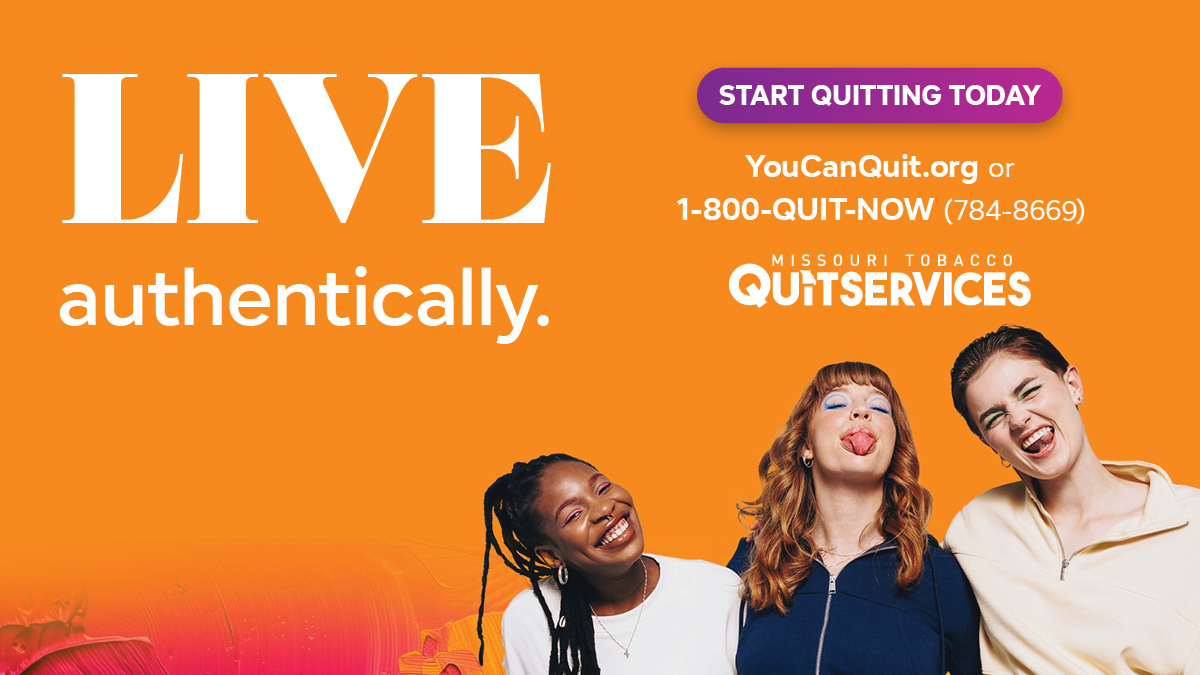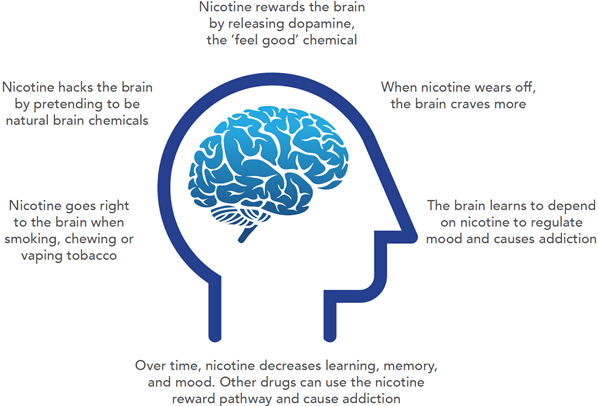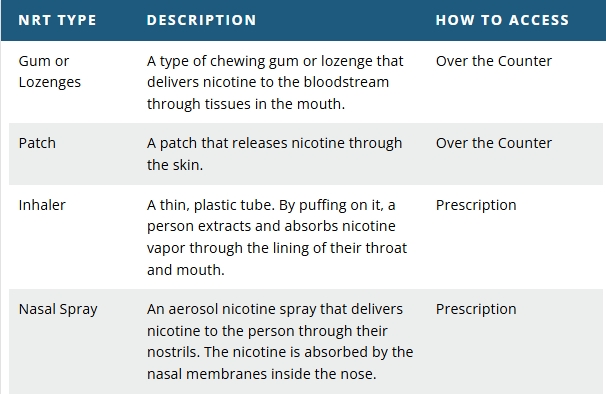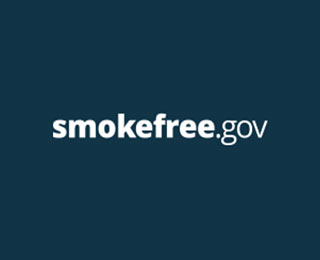Resources for Change
Strong Lungs. Strong Choices. Live Authentically and Lead the Den!

Despite the health risks, many smokers struggle to quit. Surveys indicate that most people who smoke express a desire to stop, but only a small fraction manage to stay smoke-free for at least a year. If you're a smoker who has tried to quit but hasn't succeeded, don't be disheartened. It's common to need several attempts before achieving long-term success. Learn more about tobacco, nicotine, and resources to help you quit smoking below.
Vaping (E-CIGARETTES)
Vaping is an alternative way of getting the effects of smoking tobacco or marijuana. Devices used for vaping are often referred to as e-cigarettes, vapes, or vape pens. They function by heating a chemical ("vape juice"), most commonly containing nicotine or THC, to create a aerosol that is then inhaled. This chemical sometimes has added flavors. These devices come in many forms, some look like USB drives, others like pens and others like various everyday items.
Facts About Vaping
- While e-cigarettes do contain fewer harmful chemicals than smok from burned tobacco products, they are still harmful to the body.
- There is some evidence that e-cigarette use by young adults can lead to cigarette use.
- Long-term research is need to understand fully the effects and risks of vaping.
- E-cigarettes are NOT an FDA-approved method for quitting smoking, and researchers have mluch to learn about their effectiveness and safetyl in helping smoker quit.
Vaping Risks and Health Implications
- Vaping has been linked to severe lung injuries, causing cough, shortness of breath and chest pain. Less severe symptoms including nausea, vomiting, and diarrhea have also been reported. The long-term risk of various types of cancers remains unknown.
- Nicotine is highly addictive and can negatively affect brain development, which continues through the mid-twenties.
- The liquid used in e-cigarettes contains many other harmful substances besides nicotine or THC and often has a higher concentration of nicotine than cigarettes.
*What researchers do know is that these toxic chemicals and metal have all been found in e-cigarettes: Nicotine, Propylene glycol, Carcinogens, Acrolein, Diacetyl, Diethylene glycol, Heavy metals, Cadmium, Benzene and Ultrafine particles that can be inhaled deep into the lungs.
Smokeless Tobacco
Instead of smoking tobacco, smokeless tobacco products consist of tobacco or a tobacco blend that is most often chewed, sucked on or sniffed. There are many different types of smokeless tobacco. The main types are:
- Chewing Tobacco: Sweetened, loose tobacco leaves are placed between the user's cheek and gum, held there, sometimes for hours at a time, to usually spit out or sometimes swallow the tobacco juices.
- E-Cigarettes: Electronic cigarettes or personal vaporizers are battery powered devices, which orally deliver, which orally deliver smokeless nicotine vapor, flavors and physical sensations similiar to conventional cigarettes. Even though e-cigarettes do not contain tobacco, the FDA has found cancer-causing chemicals in vapors.
- Snuff: Snuff is finely ground or shredded tobacco leaves, packaged in tins or tea bag-like pouches. A pinch is placed between the lower lip and gum or cheek and gum. Dry forms of snuff can be sniffed into the nose. The process of using snuff is also called dipping.
- Snus: Snus (pronounced snoos) is a spitless tobacco product. It comes in a pouch and users stick it between their upper lip and gums.
- Dissolvable Tobacco - These are pieces of compressed powdered tobacco, similiar to small hard candies. They dissolve in your mouth, requiring no spitting of tobacco juices. They're sometimes called tobacco lozenges, but they are not the same as the nicotine lozenges used to help you quit smoking.
Does Smokeless Tobacco Help You Quit Smoking?
Smokeless tobacco is not a safe or effective alternative for people who want to quit smoking. Nicotine gum or patch is a much safer treatment to quit smoking cigarettes. Learn more about nicotine replacement therapy and other quit resources below.
Smokeless Tobacco Risks and Health Implications
- Addiction: Because smokeless tobacco contains nicotine, the user can get addicted, just as they can with cigarettes and other tobacco products. The body may actually absorb more nicotine from chewing tobacco or snuff than it does from a cigarette.
- Cancer: Chewing tobacco and snuff contain 28 cancer-causing agents. The user's risk of esophageal, mouth, throat, lips and tongue, gum and chin cancer increases if they use smokeless tobacco products.
- Cavities: Chewing tobacco and other forms of smokeless tobacco cause tooth decay. Chewing tobacco contains high amounts of sugar and coarse particles that make the user's teeth more vulnerable to cavities.
- Gum Disease: The sugar and irritants in smokeless tobacco can cause the user's gum to pull away from their teeth in the area of their mouth where they place the chew.
- Heart Disease: Smokeless tobacco use increases the user's heart rate and blood pressure. Repeated nicotine exposure through smokeless products contributes to accelerated coronary heart disease, high blood pressure and increases the risk of fatal heart attack and stroke.
- Precancerous Mouth Lesions: Smokeless tobacco increases the user's risk of developing small white patches called leukoplakia, which are precancerous lesions, inside their mouth where the chew is most often placed.
Cigar
What Is a Cigar?
A cigar is a roll of tobacco wrapped in leaf tobacco or in a substance that contains tobacco. This is different from a cigarette, as cigarettes are wrapped in other substances that do not contain tobacco.
- Cigars contain the same addictive, toxic and carcinogenic compounds found in cigarettes and other tobacco products and are not a safe alternative.
- Regular cigar smoking can increase the risk of cancers in the throat and mouth including esophagus, larynx (voice box), pharynx (throat) and oral cavity (lip, tongue, mouth).
Key Facts about Cigars and Their Health Effects
- A singal large cigar can contain as much tobacco as an entire pack of cigarettes. Heavy cigar smoking. Heavy cigar smoking and inhaling cigar smoking may increase the risk of developing coronary heart disease.
- Researchers estimate that 9,000 premature deaths per year are attributed to cigar smoking.
- There are 4 different types of cigars, namely the little cigar, small cigar (also called cigarillos), regular cigars and premium cigar.
- Like other forms of tobacco, cigars contain radioactive elements such as radium and polonium.
Hookah
What is Hookah?
- A hookah is a water pipe used to smoke flavored tobacco.
- Hookahs are heated with charcoal and smoke passes through the water in the hookah befoore being inhaled from a mouthpiece.
- A hookah is typically smoked in groups and the mouthpiece is passed from person-to person.
- A hookah session typically lasts about 1 hour.
Hookah Risks and Health Implications
- Gram for gram, hookah smoke contains more tar, nicotine and carbon monoxide than cigarette smoke. An hour of hookah smoking delivers as much carbon monoxide to the user as a pack of cigarettes.
- Besides increasing cancer risk, the nicotine in hookah smoke can cause yellow teeth, wrinkles and erectile dysfunction. Use may also result in carbon monoxide poisoning.
- Irritation caused by the mouthpiece may give hookah users an even higher risk of cancers in the mouth than cigarette smokers.
- The water inside the Hookah does not filter out any of the harmful substances in the tobacco smoke. The water cools the Hookah tobacco smoke so that it feels less harsh. This causes more harm as it leads to deeper inhalations.

Nicotine Replacement Therapy (NRT)
As part of a comprehensive smoking cessation program, the American Heart Association recommends NRT as an effective tool to help quit smoking. NRT reduces feelings of withdrawal by giving smaller, controlled amounts of nicotine without the harmful chemicals found in cigarette smoke. This satisfies the craving for nicotine but reduces the urge to smoke. Below are a few options:

Prescription Medications
There are also non-addictive prescription medications such as bupropion (Wellbutrin®, Zyban®) and Varenicline (Chantix®). Using NRTs or prescription medications like these doubles the odds of successful quitting and maintaining cessation long-term.
Want to quit smoking? Magers Health and Wellness Center offers support to help you reach your goals. To schedule an appointment, please call 417-836-4000.



Quit for Good Resources:
Campus Resources:
- Magers Health and Wellness Center - 417-836-4000
- The Counseling Center - 417-836-5116
National Center for Chronic Disease Prevention and Health Promotion; Office on Smoking and Health
Missouri State - Tobacco Use/Smoking Policy
Missouri State - Code of Student Rights and Responsibilities
Missouri State - Map of Designated Areas Available During Events and Performances Only